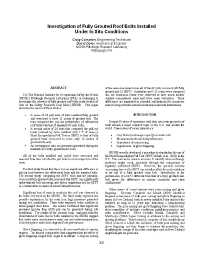Mining Publication: Investigation of Fully Grouted Roof Bolts Installed Under In Situ Conditions
Original creation date: August 2005
The NIOSH Pittsburgh Research Laboratory (PRL) continues to investigate the behavior of fully grouted roof bolts in the weak roof rock of PRL's Safety Research Coal Mine (SRCM). This paper describes the results of three studies: (1) a series of 24 pull tests of bolts installed fully grouted and overcored to leave 12 inches of grouted bolt. The tests compared the pullout performance of offset-head roof bolts with that of standard 5/8-inch bolts; (2) a second series of 24 tests that compared the pullout loads obtained by bolts installed with 1 ft of resin (a short- encapsulation pull test, or SEPT) to those of fully grouted bolts overcored to leave only 12 inches of grouted bolt; and (3) an investigation into the pressures generated during the installation of fully grouted resin bolts. All of the bolts installed and pulled were overcored and removed from the roof after the pull tests to allow inspection of the resin. The first study found that there was no significant difference in pullout load between the offset-head bolts and the standard bolts. The second study, which compared the SEPT bolts with the partially overcored fully grouted bolts, showed that SEPT can significantly underestimate bolt anchorage grip factor. This suggests that the SEPT is a conservative measure of actual bolt performance. Significant loss of resin to cracks in the roof was observed in the bolts overcored in the SRCM. The third study explored one possible explanation for the resin loss--high pressures generated during bolt installation. These tests used bolts installed in strain-gauged steel tubes. The results confirmed that significant pressures (greater than 4,000 psi) can be generated during bolt installation. The results of the pressure tests, combined with the observations of resin loss in bolts installed in the SRCM, suggest that under some circumstances resin loss and under-encapsulation could take place and lead to degraded bolt performance. Glove fingering was observed in all recovered bolts to various degrees. The limited comparative data suggested that the effect of glove fingering ranged from slight to moderate. Complete mixing of the resin was observed on all of the 40 bolts recovered (28 fully grouted and 12 SEPT). Australian and U.S. resins were compared; the Australian resins were observed to have much smaller catalyst compartment areas and lower resin viscosities. These differences are suggested as potential explanations for occasional resin-mixing problems noted in Australian resin bolt installations.
Authors: CS Compton, DC Oyler
Conference Paper - August 2005
NIOSHTIC2 Number: 20028265
In: Peng SS, Mark C, Finfinger GL, Tadolini SC, Heasley KA, Khair AW, eds. Proceedings of the 24th International Conference on Ground Control in Mining, Morgantown, West Virginia, August 2-4, 2005. Morgantown, WV: West Virginia University, 2005; :302-312
See Also
- An Analysis of Flexural Strength and Crack Width for Fiber-Reinforced Shotcrete Used in Weak Rock Mines
- Anchorage Pull Testing for Fully Grouted Roof Bolts
- Diagnosing and Controlling Moisture-Sensitive Roof in Coal Mines
- Field Performance Testing of Fully Grouted Roof Bolts
- The Introduction of Roof Bolting to U.S. Underground Coal Mines (1948-1960): A Cautionary Tale
- Mistakes, Misconceptions, and Key Points Regarding Secondary Roof Support Systems
- Neural Network Technology for Strata Strength Characterization
- Optimizing Secondary Roof Support with the NIOSH Support Technology Optimization Program (STOP)
- Performance Characteristics for Welded Wire Screen Used for Surface Control in Underground Coal Mines
- Preventing Injuries Caused by Unrecognized Stone Mine Roof Beam Failures With a Pro-Active Roof Control Plan
- Page last reviewed: 9/21/2012
- Page last updated: 9/21/2012
- Content source: National Institute for Occupational Safety and Health, Mining Program


 ShareCompartir
ShareCompartir
